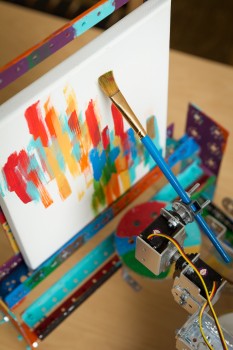Painting robot lends surgeons a hand
Would you let an artist perform life-saving surgery on you?
You might someday, if the artist is a painting robot.
Timothy Lee built a robotic painting arm that can replicate the lines and shapes a surgeon makes with a scalpel using a paintbrush and canvas. His invention, a creative blend of art and science, could one day lend doctors a hand in practicing complex, robot-assisted surgeries without having to step foot in an operating room.
Rethinking robotics
Lee, a sophomore who plans to major in chemistry, spent his high school years building everything from a robot that can balance on a beam to a robotic arm that can throw a ball. During his first year at Wake Forest, he heard about a percussion-playing robot designed by Georgia Tech researchers and started thinking about new ways to apply his hobby.
“I never really thought you could do music with robots,” he said. “That got me thinking, ‘What else can you do with robots that most people wouldn’t think about or imagine happening?’ I thought I could do something with painting and that prompted the idea of robotic surgery.”
Lee said painting and surgery have more in common than initially meets the eye. A painter has to be nimble and precise with his brushstrokes much like a surgeon must be nimble and precise with a scalpel.
“When you are dissecting a part of the human body, you have to be one hundred percent perfect,” he said. “If you think about painting something like the Mona Lisa, you have to be perfect with your brush.”
With the support of a grant from the Undergraduate Research and Creative Activities (URECA) Center, Lee teamed up with Craig Hamilton, an associate professor of biomedical engineering at Wake Forest Baptist Medical Center, and got to work on his mechanical arm.
More than painting by numbers
Lee ordered parts online and assembled his contraption. His invention took an artistic turn when he began the arduous process of teaching it how to paint.
“It is a lot harder than you might think,” Lee said. “At first I’d tell it to go five spaces to the left or five spaces to the right and things typically wouldn’t go as planned. After weeks of programming, I eventually got to the point where the robot could paint shapes and lines in a particular color.”
Lee said from there it was relatively easy to train the robot to paint something like a sunset or a house without any input from a human operator. Lee next began to teach the robot to paint lines and shapes corresponding to locations of human organs.
“Our goal was to get the robot to replicate the lines and shapes a surgeon makes with a scalpel all on its own,” he said. “You can think of a painting canvas as a body and the brush as a surgeon’s knife.”
Practicing in a surgeon’s studio
Currently, surgical robots are controlled by a human operator and do not perform procedures autonomously. While Lee’s robot may never be put to work in an operating room, it and other robots like it could one day help researchers to design fully autonomous robotic surgeons.
In addition to teaching the robot to paint autonomously, Lee also explored the idea of using his robot as a training tool for surgeons who need practice operating a da Vinci surgical arm.
“At the Wake Forest Medical Center, doctors use replica bodies to help train surgeons to use the da Vinci system,” Lee said. “These replicas are pretty expensive compared to my robotic arm, which cost around $1,500.”
This April, Lee will represent Wake Forest at the ACC Meeting of the Minds, an event where outstanding undergraduate researchers from each ACC university gather at one member university to present their research, either verbally or as a poster. This year the event will take place at the University of Pittsburgh, where Lee will demonstrate his robot’s painting abilities.
“Working with Dr. Hamilton on my robot has been a great opportunity and there are definitely still a lot of things we can still learn from it,” Lee said. “It just goes to show you that science and art are more intertwined than most people think.”
Over the next five years, Wake Will: The Campaign for Wake Forest seeks to raise $10 million to create an endowment for the URECA Center.
Categories: Arts & Culture, Experiential Learning, Inclusive Excellence, Leadership & Character, Mentorship, Pro Humanitate, Research & Discovery
Media Contact
Wake Forest News
media@wfu.edu
336.758.5237




